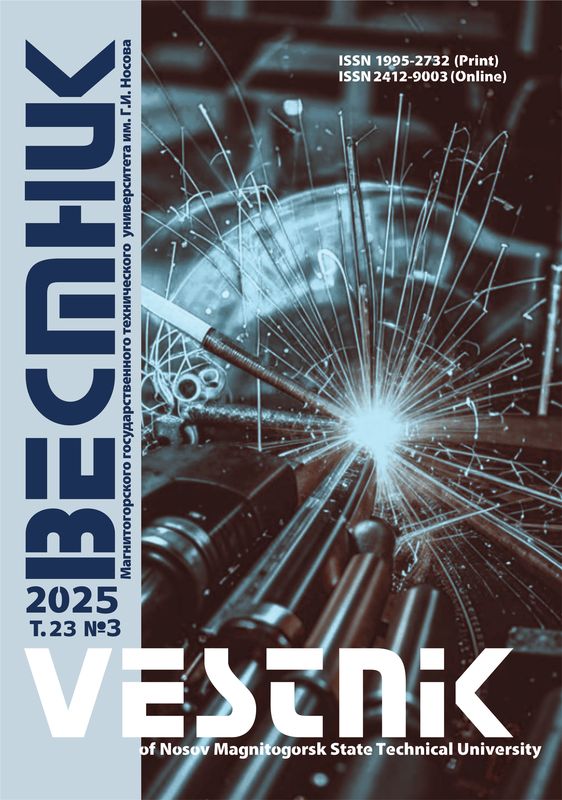Abstract
Problem Statement (Relevance): This article describes some potential benefits of using TRIP steels in the cold drawing process, which results in the final product having a wide range of additional properties such as strength, wear resistance and resistance to environmental effects. Stating the critical need to account for the microstructure of TRIP steels, the authors have formulated some important problems of the conventional approach to engineering drawing processes that exploits the finite element method. Objectives: The study aims to optimise the computer modelling techniques applied in simulation of steel drawing operations in order to increase the model’s predictive power and to study the structure forming phenomena characteristic of advanced steels. Methods Applied: An optimised multiscale modelling method was applied which helps observe the microstructure of a workpiece in process, as well as dynamic structural and phase transformations, i.e. the TRIP effect. An add-in programme was used with Abaqus to simulate the TRIP effect. Equivalent stresses and strains, as well as axial and radial deformations at the surface and in the center of the deformation zone were estimated to analyse the stress-strain state of a workpiece. Originality: This research resulted in an improved modelling technique applied in simulation of the axisymmetric cold working process that accounts for the microstructure of a workpiece in process and its transformations under strain. Due to this one can calculate the microstructural parameters of steel in a stress-strain state and look at the transformations that take place in metastable steels. Findings: The article compares the results of modelling allowing for the TRIP effect and overlooking it. The comparison shows that martensite, which forms in the microstructure, causes a significant rise of equivalent stresses across the entire representative volume, which is extremely critical in the drawing process engineering. The method applied also gave a better understanding of how the microstructural elements interact in TRIP steel under strain, which helped explain more intense (2 or 3 times as high compared with the average values) radial strains in the plastic phases close to bigger grain clusters of stronger bainite and martensite phases. The proposed technique helped increase the predictive power of initial simulation and study the structure- forming phenomena characteristic of advanced steels in a drawing process. Practical Relevance: The study helped obtain initial data that can be used to design the drawing processes for TRIP steels. This will enable advanced and technically flexible materials to be used in the conventional drawing process, thus expanding the range of applicable steels.
Keywords
Drawing, steel, TRIP effect, multiscale simulation, representative volume, stress-strain state, microstructure.
1. Gun G.S., Mezin I.Yu., Rubin G.Sh., Minaev A.A., Nazaibekov A.E., Dyja H. Research genesis in the field of steel products quality. Vestnik Magnitogorskogo gosudarstvennogo tekhnicheskogo universiteta im. G.I. Nosova [Vestnik of Nosov Magnitogorsk State Technical University]. 2014, no. 1 (45), pp. 92–97. (In Russ.)
2. Chukin M.V., Koptseva N.V., Baryshnikov M.P., Efimova Yu.Yu., Nosov A.D., Noskov E.P., Kolomiets B.A. Innovative potential of new technology behind nanostructured steel based metalware production. Vestnik Magnitogorskogo gosudarstvennogo tekhnicheskogo universiteta im. G.I. Nosova [Vestnik of Nosov Magnitogorsk State Technical University]. 2009, no. 2, pp. 64–68. (In Russ.)
3. Gun G.S., Chukin M.V., Rubin G.Sh., Mezin I.Yu., Korchunov A.G. Current issues of metalware production qualimetry during the rise of the sixth technological wave. Metallurg [Metallurgist], 2014, no. 4, pp. 92–95. (In Russ.)
4. Sarma, G.B., Radhakrishnan, B., Zacharia, T., 1998, Finite Element Simulations of Cold Deformation at the Mesoscale, Computational Materials Science, 12, 1998, 105-123.
5. Son, S.-B., Roh, H., Kang, S.-H., 2010, Relationship between microstructure homogeneity and bonding stability of ultrafine gold wire, Journal of Materials Science, 45, 236-244.
6. Watanabe, I., Setoyama, D., Nagasako, N., Iwata, N., Nakanishi, K., 2012, Multiscale prediction of mechanical behavior of ferrite–pearlite steel with numerical material testing, International Journal for Numerical Methods in Engineering, 89, 829–845.
7. Fischer, F.D., Reisner, G., Werner, E., Tanaka, K., Cailletaud, G., Antretter, T., 2000. A new view on transformation induced plasticity (TRIP). International Journal of Plasticity 16 (7–8), 723–748.
8. Bleck, W., Schael, I., 2000. Determination of crash-relevant material parameters by dynamic tensile tests. Steel Research 71, 173–178.
9. Choi, I.D., Bruce, D.M., Kim, S.J., et al., 2002. Deformation behavior of low carbon TRIP sheet steels at high strain rates. ISIJ International 42, 1483–1489.
10. Kim YG, Kim TW, Han JK, Chang RW. Development of new austenitic Fe-Mn-Al-C steels for automotive applications. Key Eng Mater 1993;84:461–72.
11. Grässel O, Krüger L, Frommeyer G, Meyer LW. High strength Fe-Mn-(Al,Si) TRIP/TWIP steels development – properties – application. Int J Plast 2000;16:1391–409.
12. Frommeyer G, Brüx U, Neumann P. Supra-ductile and high-strength manganese-TRIP/TWIP steels for high energy ab-sorption purposes. ISIJ Int 2003;43:438–46.
13. Balzani, D., Schroder, J., 2008. Some basic ideas for the reconstruction of statistically similar microstructures for mul-tiscale simulations, Proc. Appl. Math. Mech., 8, 10533-10534.
14. Wiewiorowska, S. Determination of content of retained aus-tenite in steels with TRIP effect deformed at different strain rates, Steel Research International. 81 (2010) 262-265.
15. Wiewiorowska, S. The influence of strain rate and strain in-tensity on retained austenite content in structure of steel with TRIP effect. Solid State Phenomena, 165 (2010) 216-222.












